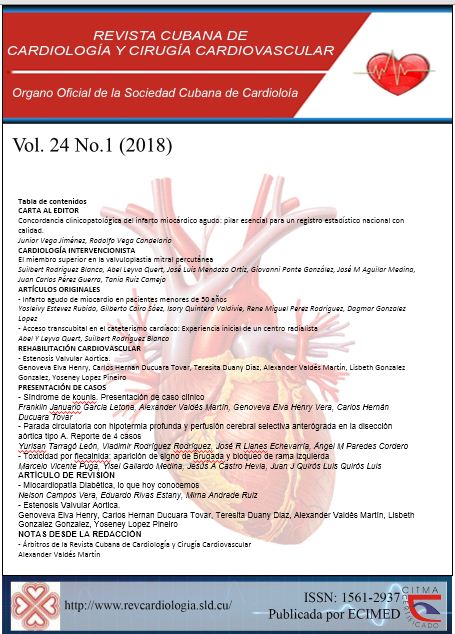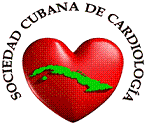Toxicidad por flecainida: aparición de signo de Brugada y bloqueo de rama izquierda
Palabras clave:
toxicidad por flecainida, síndrome de Brugada, bloqueo de rama izquierda, taquicardia por reentrada intranodalResumen
Se trata de una paciente femenina de 47 años, que presentó episodio de taquicardia por reentrada intranodal y se inició tratamiento con flecainida, sin recurrencias. Luego de dos años de tratamiento presentó toxicidad por ese fármaco, que se manifestó eléctricamente con aparición de un bloqueo de rama izquierda y posteriormente del patrón convexo del síndrome de Brugada, cambios eléctricos que desaparecieron al suspender el antiarrítmico. Se realizó posteriormente ablación exitosa de la vía lenta del circuito de la arritmia.
Descargas
Citas
Antzelevitch C, Yan GX. J-wave syndromes: Brugada and early repolarization syndromes. Heart Rhythm. 2015;12:1852-1866.
Priori SG S, Blomström-Lundqvist C, Mazzanti A, Blom N, Borggrefe M, Camm J, et al. ESC Guidelines for the management of patients with ventricular arrhythmias and the prevention of sudden cardiac death: death: the task force for the management of patients with ventricular arrhythmias and the prevention of sudden cardiac death of the ESC. Eur Heart J. 2015;36:2793-2867.
Priori S, Wilde A, Horie M, Cho Y, Behr E, Berul C, et al. HRS/EHRA/APHRS expert consensus statement on the diagnosis and management of patients with inherited primary arrhythmia syndromes. Europace. 2013;15:1389-1406.
Issa Z, Miller J, Zipes D. Clinical arrhythmology and electrophysiology. A companion to Braunwald’s heart disease. Segunda ed. Saunders , editor. Philadelphia: Elsevier Saunders; 2012.
Page R, Joglar J, Caldwell M, Calkins H, Conti J, Deal B, et al. ACC/AHA/HRS Guideline for the management of adult patients with supraventricular tachycardia. J Am Coll Cardiol. 2016; 67(13):e27-115.
Yan G, Antzelevitch C. Cellular basis for the electrocardiographic J wave. Circulation. 1996;93:372-379.
Yan G, Antzelevich C. Cellular basis for the Brugada syndrome and other mechanisms of arrhythmogenesis associated with ST segment elevation. Circulation. 1999;100:1660-1666.
Antzelevitch C, Yan G. Cellular and ionic mechanisms responsible for the Brugada syndrome. J Electrocardiol. 2000; 3(Suppl):33-39.
Koncz I, Gurabi Z, Patocskai B, Panama B, Szel T, Hu D, et al. Mechanisms underlying the development of the electrocardiographic and arrhythmic manifestations of early repolarization syndrome. J Mol Cell cardiol. 2014;68C:20-28.
Stanley N, Bernard G, Opie L. Antiarrhythmic drugs and strategies. In Saunders , editor. Drugs for the heart. Philadelphia: Elsielver Saunders; 2013. 283-284.
Shimizu W, Antzelevitch C, Suyana K, Kurita T, Taguchi A, Aihara N, et al. Effect of sodium channel blockers on ST segment, QRS duration, and corrected QT interval in patients with Brugada syndrome. J Cardiovasc Electrophysiol. 2000;11:1320-1329.
Morita H, Morita S, Nagase S, Banba K, Nishii N, Tani Y, et al. Ventricular arrhythmia induced by sodium channel blocker in patients with Brugada syndrome. J Am Coll cardiol. 2003;42:1624-1631.
Valentino M, Panakos A, Ragupathi L, Williams J, Pavri B. Fleclainide toxicity: A case report and systematic review of its electrocardiographic patterns and management. Cardiovasc Toxicol. 2017;17:260-266.
Abdulrahman N, Elijah RB, Velislav NB. Electrocardiographic methods for diagnosis and risk stratification in the Brugada syndrome. J Saudi Heart Assoc. 2015;27:96-108.
Probst V, Veltmann C, Eckardt L, Meregalli PG, Gaita F, Tan HL, et al.. Long-term prognosis of patients diagnoses with Brugada syndrome: Results from the FINGER Brugada Syndrome Registry. Circulation. 2010;121:635-643.
Okamura H, Kamakura T, Morita H, Tokioka K, Nakajima I, Wada M, et al. Risk stratification in patients with Brugada syndrome without previous cardiac arrest – prognostic value of combined risk factors –. Circ J. 2015;79:310-317.
Publicado
Cómo citar
Número
Sección
Licencia
Aquellos autores/as que tengan publicaciones con esta revista, aceptan los términos siguientes:- Los autores/as conservarán sus derechos de autor y garantizarán a la revista el derecho de primera publicación de su obra, el cuál estará simultáneamente sujeto a la Attribution-NonCommercial 4.0 Internacional (CC BY-NC 4.0) que permite a terceros compartir la obra siempre que se indique su autor y su primera publicación esta revista. o admite fines comerciales. Permite copiar, distribuir e incluir el artículo en un trabajo colectivo (por ejemplo, una antología), siempre y cuando no exista una finalidad comercial, no se altere ni modifique el artículo y se cite apropiadamente el trabajo original. El Comité Editorial se reserva el derecho de introducir modificaciones de estilo y/o acotar los textos que lo precisen, comprometiéndose a respectar el contenido original.
- Los autores/as podrán adoptar otros acuerdos de licencia no exclusiva de distribución de la versión de la obra publicada (p. ej.: depositarla en un archivo telemático institucional o publicarla en un volumen monográfico) siempre que se indique la publicación inicial en esta revista.
- Se permite y recomienda a los autores/as difundir su obra a través de Internet (p. ej.: en archivos telemáticos institucionales o en su página web) antes y durante el proceso de envío, lo cual puede producir intercambios interesantes y aumentar las citas de la obra publicada. (Véase El efecto del acceso abierto).









